Because It's There: Linux
on Virtual PC
© 2000 Washington
Apple Pi Labs
Washington Apple Pi Journal, March/April 2000,
pp. 44-46, reprint
information
Washington Apple Pi Labs has always
enjoyed challenges. From the very beginning, whenever that
was, we strove to do the impossible, the improbable, and
sometimes the clearly silly. When we first got our hands on
a gigabyte hard drive, for example, we immediately plugged
it into a Macintosh IIfx (at that time, the file server for
the Pi's bulletin board, the TCS), and set virtual memory to
a full billion bytes. Then, flush with all this imitation
memory, we launched, simultaneously, every single
application we could find, even going so far as to install
an extra 20 or 30 so we could have them all running at
once.
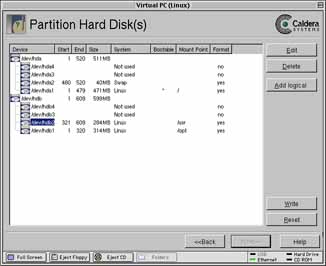
|
|
The advanced partitioning
options of the OpenLinux 2.3 installer were used to
create several partitions in Virtual PC 3.0. This
is not for the faint of heart (and, in fact, this
partitioning attempt proved to be unsuccessful).
Note the Virtual PC icons at the bottom of the
screen, used for changing the screen size and
accessing various types of media.
|
It was grand and glorious, a prime
example of conspicuous computing. It was also painfully slow
and, admittedly, without a readily identifiable purpose,
particularly when we ran out of applications before using up
more than a third of the memory. So: why?
|
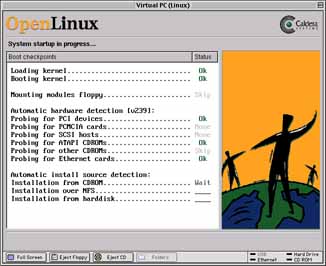
|
|
During the installation
process, the installer checks out the (emulated)
hardware to see what "devices" are available. A
device, in typical UNIX fashion, can be something
physical, such as a CD-ROM drive, or a "logical"
device, such as a hard drive partition.
|
Why would anyone in their right
mind want to install an Intel version of Linux on a
Macintosh? Since the Mac doesn't use an Intel central
processing unit (CPU), this seems a strange thing to do,
especially when there are perfectly good PowerPC-specific
versions of Linux available. So: why?
|
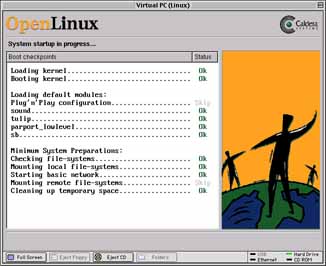
|
|
After installation,
instead of colorful (and cryptic) startup icons,
Caldera's version of Linux offers nice, clear (and
still cryptic) milestones of where it is in the
boot process. The "Plug 'n' Play" and "tulip"
milestones are the target of frequent humor.
|
George Mallory, attempting to climb
Mount Everest in 1924, was asked the same simple question:
why? "Because it's there" was his famous answer. On June 8,
1924, Mallory disappeared on Everest. Seventy-five years
later, on May 2, 1999, Mallory's frozen body was found on
the mountain. No one knows if he ever made it to the
top.
|
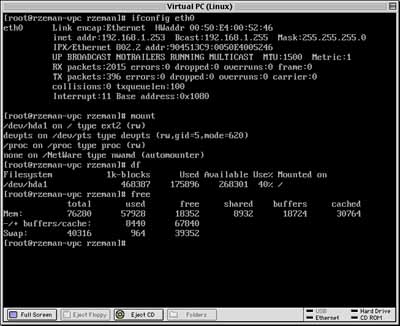
|
|
Once Linux has initialized
and you've signed on, you have the option of
opening up a terminal window (tty console) and
trying out the famous, easy to understand UNIX CLI
(command line interface).
|
Half a world away and several miles
closer to sea level, Washington Apple Pi Labs still thinks
Mallory had the right idea: "Because it's there." Or at
least it might be, given a late-model translucent-cased
Power Macintosh, lots of memory, lots and lots of free hard
drive space, Virtual PC 3.0 from Connectix, and one of the
many "commercially packaged" versions of Linux. So on a
frozen January morning, with the entire East Coast shut down
by a surprise blizzard, Washington Apple Pi Labs attempted
something you probably don't want to ever do
yourself.
|
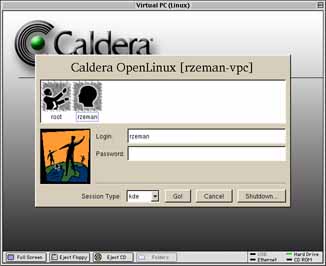
|
|
Every time you boot, you
are presented with a graphical dialog box asking
for name and password. Note the pop-up menu in the
lower left offering you a choice of interface
types.
|
And, since you also probably aren't
interested in anything other than the pictures, we'll offer
just an executive summary. First, Virtual PC was used to
create an emulated Pentium computer. Next, the default
Windows operating system was blown away. Next, the Linux
installer application was fired up from CD-ROM, and Linux
was installed. And installed. And installed. (It takes a
while.)
|
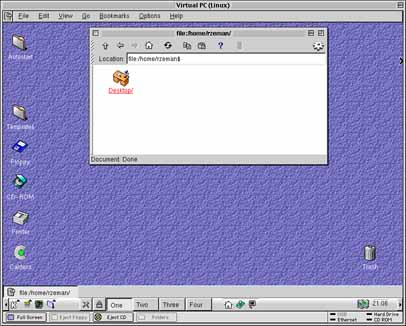
|
|
If you select KDE (which
stands for "K Desktop Environment") when you first
log in, you are presented with this cheery
graphical user interface, patterned after the
browser mode of Microsoft Windows 98. Thus, after
hours of work, you can stand proud, knowing that
you have a UNIX emulation of Windows 98 running on
an emulated PC running on a Macintosh. The "K" in
KDE, by the way, apparently stands for nothing
other than the letter between "J" and "L."
|
Many hours later, we had reached a
conclusion: yes, you can run Virtual PC 3.0 and, within
Virtual PC, fully install and operate Linux. If you wish,
you can even run one of the Windows-like graphical
interfaces to Linux on your emulated Pentium running on your
Power Macintosh, complete with network services. Of course,
it redefines the word "slow," but it does work.
|
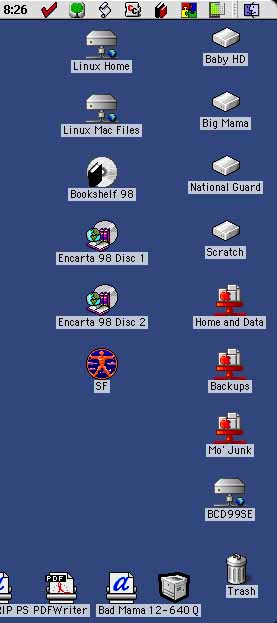
|
|
7.virtualdiscs.tiff: While
not directly related to this project, this window
shows a "good use" for a Linux machine: CD-ROMs
saved as Linux disk images, mounted under Linux and
shared over a network via netatalk so they can
appear -- and be used -- on a Macintosh desktop.
Yes, there are less Byzantine ways of doing the
same thing, but they probably aren't nearly as
entertaining.
|
It is also a safer way to spend
your time than climbing nearly six miles into the sky
without oxygen. Why do this? Because it's there.
|





![]()